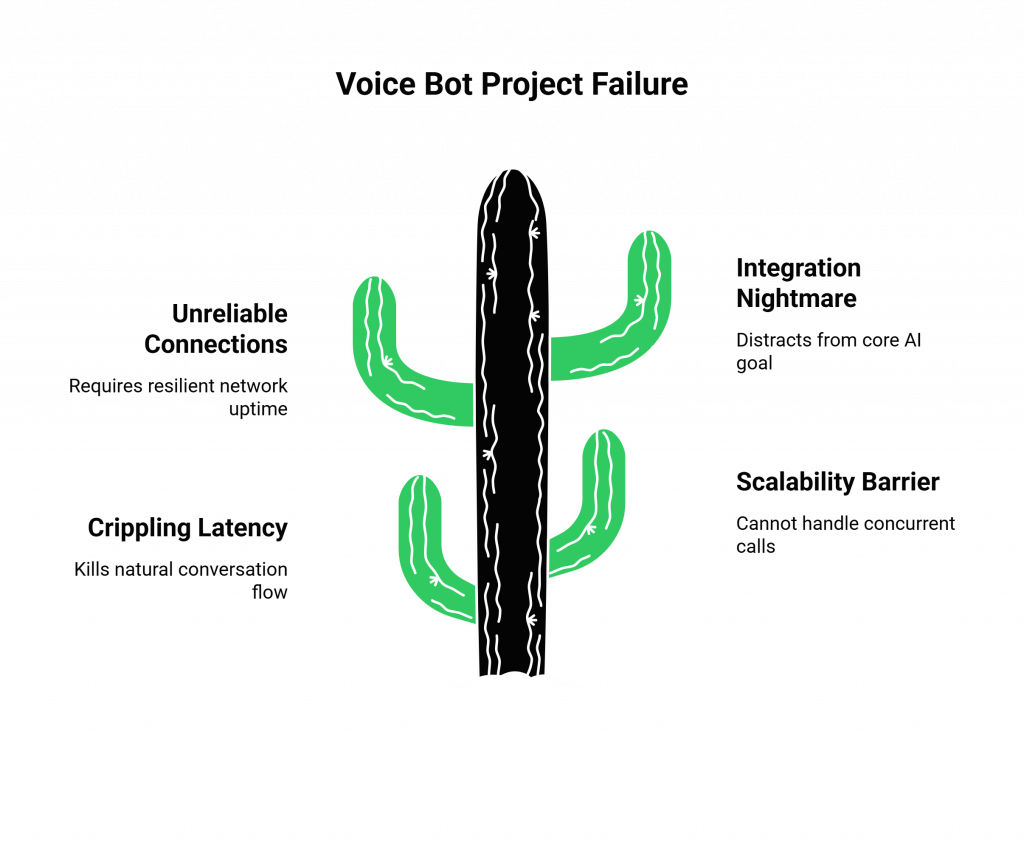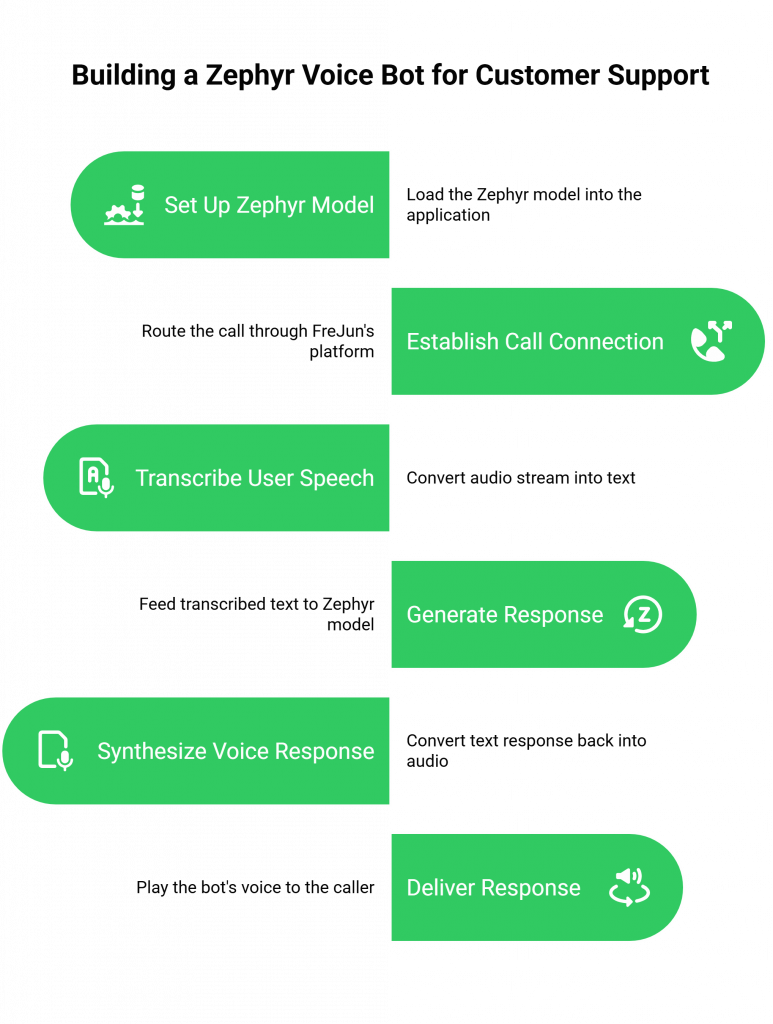The rise of powerful, open-source large language models (LLMs) has fundamentally changed the landscape of artificial intelligence. Businesses are no longer limited to closed, proprietary systems. Instead, they can harness the power of transparent, adaptable models to build custom conversational AI solutions. This is particularly transformative for customer support, where the ability to create a specialized, fine-tuned agent can be a significant competitive advantage.
Table of contents
- The Open-Source Advantage in Customer Support AI
- The Production Wall: Why Your Voice Bot Project is Failing
- FreJun: The Enterprise-Grade Voice for Your Open-Source AI
- The Core Technology Stack for a Production-Ready Voice Bot
- How to Build a Zephyr Voice Bot for Customer Support?
- DIY Infrastructure vs. FreJun: A Head-to-Head Comparison
- Best Practices for Optimizing Your Zephyr Voice Bot
- Final Thoughts
- Frequently Asked Questions (FAQs)
The Open-Source Advantage in Customer Support AI
Models like Zephyr 7B Beta have emerged as strong contenders in this new era. Known for its excellent performance in multi-turn dialogues and its support for memory-enabled conversations, Zephyr provides a powerful foundation for building intelligent agents. However, a brilliant AI brain is only one half of the equation. To be effective in the real world, that brain needs a voice, and that voice must function flawlessly over a live telephone line. This is where the real challenge begins.
The Production Wall: Why Your Voice Bot Project is Failing
Many development teams, excited by the potential of an open-source model like Zephyr, successfully build an impressive proof-of-concept. The bot works perfectly in a controlled lab environment, taking input from a laptop microphone and responding with intelligence. But when the time comes to move from this local demo to a live, production system that can handle real customer calls, the project often hits a wall.

This production wall is built from the immense, often underestimated complexity of telephony infrastructure. Building a system that can reliably connect a telephone call to an AI application in real-time is a monumental task, filled with challenges:
- Crippling Latency: The delay between a caller speaking and the bot responding is the number one killer of a natural conversation. High latency leads to awkward pauses, interruptions, and a frustrating user experience.
- The Scalability Barrier: A Python script running on a single server cannot handle hundreds or thousands of concurrent calls during peak business hours.
- Unreliable Connections: Ensuring crystal-clear audio and 99.99% uptime requires a resilient, geographically distributed network, which is incredibly expensive and complex to build and maintain.
- Integration Nightmare: Stitching together telephony carriers, SIP trunks, and real-time media streaming protocols requires highly specialized expertise and distracts from the core goal of building a great AI.
This infrastructure hurdle is why so many promising voice bot projects fail, consuming vast resources on “plumbing” instead of perfecting the conversational experience.
FreJun: The Enterprise-Grade Voice for Your Open-Source AI
FreJun was created to demolish this production wall. We believe that businesses should be able to leverage the best open-source AI models without having to become telecommunications experts. FreJun handles the complex voice infrastructure so you can focus on building your AI.
Our platform serves as the critical bridge between your Zephyr application and the global telephone network. We provide a robust, developer-first API that manages the entire voice layer, from call connection to real-time audio streaming. By abstracting away the complexity of telephony, we enable you to turn your text-based Zephyr model into a powerful, production-ready Zephyr voice bot for customer support.
The Core Technology Stack for a Production-Ready Voice Bot
A modern voice bot is not a single piece of software but a pipeline of specialized services working in harmony. For a bot powered by Zephyr, a typical high-performance stack includes:
- Voice Infrastructure (FreJun): The foundational layer. It connects to the telephone network, manages the call, and streams audio to and from your application in real-time.
- Automatic Speech Recognition (ASR): A service that transcribes the caller’s raw audio into text.
- Conversational AI (Zephyr 7B Beta): The “brain” of the operation. Your custom Zephyr application processes the transcribed text and generates an intelligent, contextual response.
- Text-to-Speech (TTS): A service like ElevenLabs or Google TTS that converts the AI’s text response into natural-sounding speech.
FreJun is model-agnostic, giving you the freedom to assemble your preferred stack while we handle the most complex and critical piece: the voice transport layer.
How to Build a Zephyr Voice Bot for Customer Support?

While many online tutorials start with capturing microphone audio, a real business application starts with a phone call. This guide outlines the production-ready pipeline.
Step 1: Set Up Your Zephyr Model
Before your bot can think, its brain needs to be running.
- How it Works: Use Hugging Face Transformers to load the Zephyr 7B Beta model into your application. You can run it locally on appropriate hardware or on a cloud server. Ensure you have an API endpoint ready to receive text prompts and return AI-generated responses.
Step 2: Establish the Call Connection with FreJun
This is where the real-world interaction begins. A customer dials your business phone number.
- How it Works: The call is routed through FreJun’s platform. Our API establishes the connection and immediately begins providing your application with a secure, low-latency stream of the caller’s voice.
Step 3: Transcribe User Speech with ASR
The raw audio stream from FreJun must be converted into text.
- How it Works: You stream the audio from FreJun to your chosen ASR service. The ASR transcribes the speech in real time and returns the text to your application server.
Step 4: Generate a Response with Your Zephyr Application
The transcribed text is fed to your Zephyr model.
- How it Works: Your application takes the transcribed text and appends it to a chat message list that maintains the conversation history. It’s critical to use Zephyr’s specific chat template, which includes system, user, and assistant roles, to maintain context. The system passes this formatted history to the Zephyr model to generate a relevant, conversational reply.
Step 5: Synthesize the Voice Response with TTS
The text response from Zephyr must be converted back into audio.
- How it Works: The text is passed to your chosen TTS engine. To maintain a natural flow, it is critical to use a streaming TTS service that begins generating audio as soon as the first words of the response are available.
Step 6: Deliver the Response Instantly via FreJun
The final, crucial step is playing the bot’s voice to the caller.
- How it Works: You pipe the synthesized audio stream from your TTS service directly to the FreJun API. Our platform plays this audio to the caller over the phone line with minimal delay, completing the conversational loop and creating a seamless, interactive Zephyr voice bot for customer support.
DIY Infrastructure vs. FreJun: A Head-to-Head Comparison
When building a Zephyr voice bot for customer support, you face a critical build-vs-buy decision for your voice infrastructure. This choice will define the speed, cost, and ultimate success of your project.
| Feature / Aspect | DIY Telephony Infrastructure | FreJun’s Voice Platform |
| Primary Focus | 80% of your resources are spent on complex telephony and network engineering. | 100% of your resources are focused on building and refining the AI conversational experience. |
| Time to Market | Extremely slow (months or even years). Requires hiring a team with rare and expensive telecom expertise. | Extremely fast (days to weeks). Our developer-first APIs and SDKs abstract away all the complexity. |
| Latency | A constant and difficult battle to minimize the conversational delays that make bots feel robotic. | Engineered for low latency. Our entire stack is optimized for the demands of real-time voice AI. |
| Scalability & Reliability | Requires massive capital investment in redundant hardware, carrier contracts, and 24/7 monitoring. | Built-in. Our platform is built on a resilient, high-availability infrastructure designed to scale with your business. |
| Maintenance | You are responsible for managing carrier relationships, troubleshooting complex failures, and ensuring compliance. | We provide guaranteed uptime, enterprise-grade security, and dedicated integration support from our team of experts. |
Best Practices for Optimizing Your Zephyr Voice Bot
Building the pipeline is the first step. To create a truly effective Zephyr voice bot for customer support, follow these best practices:
- Fine-Tune on Your Data: The greatest advantage of an open-source model like Zephyr is the ability to fine-tune it on your own data. Use your company’s customer support call transcripts to create a highly specialized agent that excels at classifying your specific issues and providing relevant answers.
- Use Structured Chat History: Strictly adhere to Zephyr’s chat template, using system messages to define the bot’s persona and instructions (e.g., “You are a friendly and helpful support agent.”). This ensures consistent and predictable behavior.
- Implement Robust Context Management: A coherent, multi-turn conversation depends entirely on maintaining accurate context. Ensure your application correctly stores and sends the role-content pairs for the entire conversation history with every turn.
- Test in Real-World Conditions: Move beyond testing with clean audio. Use real phone calls and test with diverse accents, background noise, and varying connection quality to ensure your bot is robust and reliable.
Pro Tip: Use platforms like Predibase or Ludwig, which offer open-source tools and notebooks, to simplify the process of fine-tuning your Zephyr model on your custom customer support datasets.
Final Thoughts
The availability of powerful open-source models like Zephyr presents a transformative opportunity for businesses to build custom AI solutions. But a powerful AI is not, by itself, a business product. It needs to be connected, reliable, and scalable. It needs a voice.
By building on FreJun’s infrastructure, you make a strategic decision to bypass the most significant risks and costs associated with voice AI development. You can focus your valuable resources on what you do best: creating an intelligent, engaging, and valuable customer experience with your custom-tuned Zephyr voice bot for customer support. Let us handle the complexities of telephony, so you can build the future of your business communications.
Further Reading – Design a Conversational Voice Bot with API Flexibility
Frequently Asked Questions (FAQs)
Zephyr 7B Beta is a powerful, open-source large language model known for its strong performance on multi-turn conversational tasks. Its adaptability makes it an excellent choice for building custom customer support voice bots.
No. FreJun is the specialized voice infrastructure layer. Our platform is model-agnostic, meaning you bring your own AI model (like Zephyr), Automatic Speech Recognition (ASR), and Text-to-Speech (TTS) services. This gives you complete control and flexibility.
Fine-tuning allows you to train the base model on your own specific data (e.g., call transcripts). This makes the model an expert in your business domain, improving its accuracy in understanding customer intents and providing relevant solutions. This is a key advantage of a Zephyr voice bot for customer support.
A chat template is a specific format that the model expects for conversational input. For Zephyr, this involves structuring the conversation with system, user, and assistant roles. Using the correct template is critical for the model to understand the context and flow of the dialogue correctly.
Low latency is essential for a natural conversation. Long delays between a user speaking and the bot replying create awkward silences and lead to users interrupting the bot, causing a frustrating and ineffective experience.
